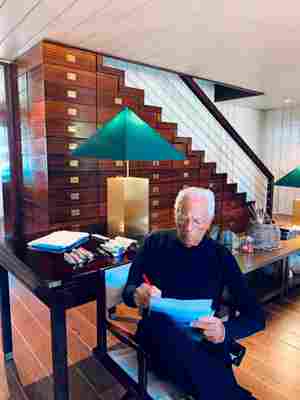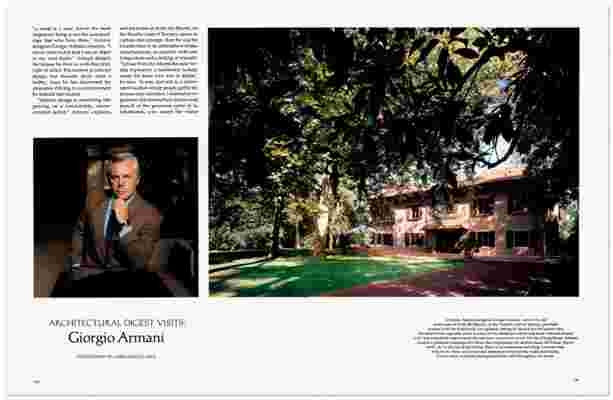With apologies to the Bible, Giorgio Armani’s house has many mansions. There’s the palazzo in the fashion designer’s home base of Milan, a New York City penthouse, the island compound off Tunisia, and the chalet near St. Moritz, along with plush perches in Paris, Lombardy, Antigua, and beyond. But the address that possesses great sentimental value is the former farmhouse that he smartly remodeled in the 1980s, and still owns, in Forte dei Marmi, a seaside hot spot on Tuscany’s Versilia Coast.
“I’ve changed very little in the house since then, and it has lived incredibly well over the years,” says the fashion designer, who celebrated his 86th birthday and the 45th anniversary of his company this past July. The stucco-clad residence first appeared in AD’s May 1983 issue. Restrained yet inviting, it remains spare in furnishings, simple in finishes, strict in palette, and surprisingly free of superfluous objects, other than a discreet souvenir or two (“even silly things like seashells”) that remind him of a person or a place. That being said, some alterations have been made over the decades: a steam bath, the gym, some sofas. “But nothing else,” he admits. “I feel very comfortable with the way it is.”

A recent image of the designer in the living area.
Armani’s admirers take inspiration from the Forte dei Marmi rooms time and again, flipping through vintage issues of AD or immersing themselves in the magazine’s archives on AD PRO. “My first thought on seeing the original article again was, ‘Oh, my God, that coconut matting on the floor!’” says Patrick McGrath, a Manhattan interior designer whose C.V. includes an impressionable stint as the head of visuals for Giorgio Armani North America. “It’s all about simple carpets, white walls, a little Josef Hoffmann desk in a studio, and no art. The interiors are supposed to take second place to the life that’s going on inside them, which is a nice way to look at what could be described as a blank slate. The people are the ornaments.”
Faultless white aluminum panels rise up walls and across ceilings like ultramodern shiplap, interrupted here and there by virtual pilasters of polished wood. “The natural element is important,” Armani observes, “because sterile colors or materials do not allow the transmission of emotions.” The same neutral matting spread throughout the house rises up the staircase, too, the latter’s treads follow the ziggurat profile of a built-in storage unit that is equipped with dozens of wide drawers. Part chest and part architecture, it recalls a stepped Japanese kaidan-dansu chest. As for the monumental sofas and chairs, they are so elemental that one could imagine them as successfully upholstered in princely brocades or Indian printed cottons as they are in Armani’s signature sand tones.

For access to all 100 years of the AD archive, join AD PRO, the members-only community for design professionals, at archdigestproom .
“I have a particular predilection for the 1920s and 1930s, that is to say the Art Deco period, as well as Japanese and Chinese styles from the same cultural scene,” the designer continues, noting his admiration for the reductionist raffinement of prewar French designers Jean-Michel Frank and Pierre Chareau. “I have some pieces that belong to that period, and I think they have everlasting appeal because of the purity of form. Beauty is delivered with sophisticated materials and workmanship of the highest quality.”
When Will Cooper, creative director of the AD100 design firm ASH NYC, recently reexamined Armani’s Forte dei Marmi rooms as featured in AD , his admiration was expressed in a declarative, unimpeachable phrase: spot on. “From a macro perspective, they are a full expression of the Armani brand, a perfect distillation of his fashion sense in an interior,” he adds. “The simplicity of the house is so strong, and the forms are so perfect, and at a time when Italian design meant Memphis to many people. Instead of exposed bulbs, he created a shaded lamp that cast light more evocative of entertaining. Armani/Casa still makes the pyramidal shade but not the brass base, which is so annoying, because I’ve loved it forever and ever.”